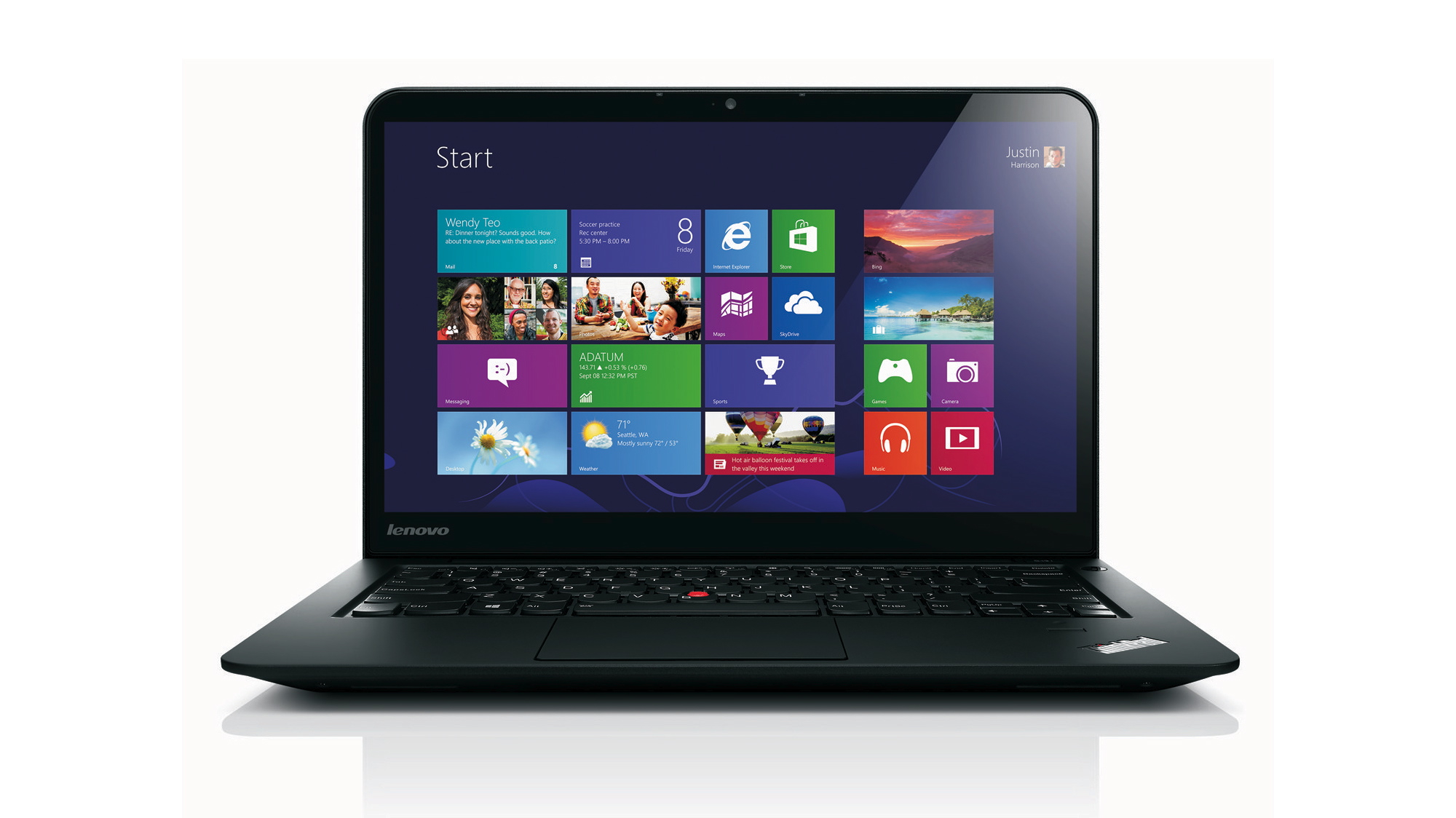Why you can trust TechRadar
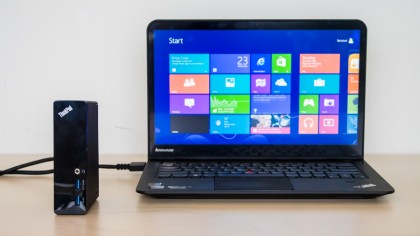
Business and productivity-minded users will appreciate Lenovo's optional OneLink Dock ($120), which uses Lenovo's new proprietary OneLink Connector to charge the laptop and connect it to a monitor and keyboard.
Measuring 5.32 x 1.5 x 3.59 inches and weighing 0.3 pounds (small enough to travel with), the discrete-looking black dock has two USB 3.0 ports and an audio jack on the front. Located on the back are two USB 2.0 ports (for keyboard/mouse), HDMI video out, the OneLink connector for the S431, and a Gigabit Ethernet jack. On top of the dock is a second power button.
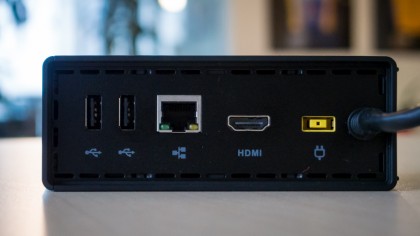
We like the OneLink Dock because it is a one-cable solution that produces no visual or performance degradation in any way, unlike some USB-based docking connectors.
Bundled Software
The S431 comes with Lenovo's standard load-out—Norton Security, Nitro Pro 8 PDF reader, LoJack's Absolute Data Protect package, and Lenovo's proprietary system management suite. There's no obvious bloatware here, although power users might disagree. We've seen a lot worse on productivity-oriented systems from Dell and HP, that's for sure.
Hidden away in Lenovo's proprietary settings option is an interesting touch that we wish was built into Skype as a default feature. Lenovo's audio settings tool allows you to toggle on a keyboard-click noise reduction filter for your microphone, which in theory prevents your co-workers from hearing you typing away (and not paying attention) during calls. In practice, this worked very well for the built-in keyboard (which doesn't have a loud clack anyway), but only moderately well for the loud clack of the mechanical keyboard we plugged into the system. Whatever the case, it's a nice touch.
Business class keyboard and mouse
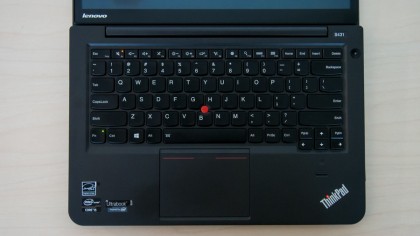
There's no better way to test a laptops keyboard and mouse controls than by writing a beefy TechRadar review on one. As deadline approaches, the cadence of inputting words and data tends to accelerate in a way that flushes out all the flaws of a laptop's keyboard or track pad.
As mentioned up at the top of this review, we initially had concerns regarding the S431's track pad. Most other laptops—Apple's MacBooks included—don't travel much upon click. In contrast, the S431's pad moves downward a great deal when you press it. Surprisingly, we discovered that after a few days of pounding away on the clickpad, it didn't bother us at all, and took no getting used to. In fact, in relatively short order, we found ourselves convinced that this is actually one of the best PC laptop track pads we've ever tested. (Apple's MacBook is still the standard bearer for mouse controls, however.)
Here's why we think it works. Far too often with other PC pads, the absence of a strong, audible and tactile "click" on most non-Mac laptops results in a frustratingly high number of false-positive mouse-clicks—moments when you think you've pressed the mouse button, but really haven't. The travel and the distinct-sounding "plunk" you get when you left- or right-click here eliminates that entirely.
More important than the clicking sensation of the pad, the ThinkPad's track pad exhibited the right amount of sensitivity to mouse controls, swipes, and even Windows 8 gestures. For business users, this is a mission-critical feature, and we're pleased that Lenovo got it right. We encountered sensitivity and input errors about as often as we do on our MacBook Air, which is to say not really at all. That's world class.
The keyboard itself, like most of the Lenovo keyboards these days, is top notch, with excellent responsiveness, and a satisfying amount of tactile feedback. The S431's magnesium chassis creates a pleasantly sturdy, decidedly non-flexing experience while typing away.
It's also backlit, which is not just nice, but increasingly an essential feature for modern laptops.
Only two aspects of the keyboard annoyed us, and both are fairly subjective. The first thing that slowed us down was the relative placement and half-sized nature of the of the cursor keys, which are located in the bottom right-hand corner of the laptop in the same three by three grid as the PgUp and PgDn keys. This close proximity, combined with the smaller size of the cursor keys resulted in us accidentally striking the PgDn key while attempting to maneuver the right cursor with our pinkie.
The second was the location of the Function key, which is just to the left of the CTRL key, and often led to us incorrectly entering keyboard shortcuts. Not surprisingly, FN + C does absolutely nothing when pressed. Hey, maybe this is good incentive to begin reaching up to touch the screen instead of operating the cursor like cavemen.
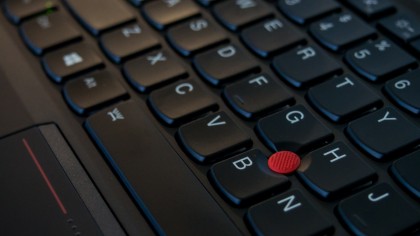
And what about the red thumb control? Sad to say, but 10 years after being red button devotees, we're over it. Truthfully, it was always a compensation of sorts for insufficient touchpad controls, and now that laptop makers have mastered them, we see no need to operate our Windows pointer with our thumbs. This said, it's there if you're still attached to it, which some long-time ThinkPad users will certainly appreciate.
Finally, the ability to just reach up and touch the screen works well as a primary OS interface—particularly when navigating between Metro (which we still don't use that much) and the Windows desktop itself.
Benchmarks
- 3DMark: Ice Storm: 27,757 // Cloud Gate: 3,089 // Fire Strike: 416
- PCBench 8: Home score: 2,535 (non-accelerated) // Battery test: 153 minutes, 16 seconds
- Battery Eater: 101 minutes
- Cinebench: 8,214
- 3DMark06: 4,133
The upshot of the above numbers is that the S431 Touch isn't going to win any benchmarking medals. However, at the $939 price point, it definitely holds its own, and outputs solid performance across basic productivity-oriented and CPU-intensive tasks.
Not surprisingly, this ThinkPad and Intel's integrated graphics part gets absolutely hammered by the more graphics-intensive benchmarks like 3DMark's Cloud Gate and Fire Strike tests. For what it's worth, we were able to play indie games on Steam like Papers Please or even the slightly more graphically challenging The Wolf Among Us. You will not be able to play modern shooters at anything above 640 x 480, however—and that's at the lowest quality settings across the board.
The good news is that, in comparison to less expensive ultrabooks like ASUS' V550CA or Acer's Aspire v5, this ThinkPad justifies the roughly 10% jump in price with a greater-than-10% leap in performance. And while it comes close to the range of higher-caliber laptops and ultrabooks like Samsng's Ativ 9 and the ThinkPad X1, it's not close enough to call the S431's performance a coup.
Like many Windows 8 ultrabooks, we found day-to-day performance to be snappy and responsive in all regards. It turns on quickly and instantly drops out of sleep mode. Concerns about the mechanical drive slowing the system down were unfounded; the presence of the 24GB of solid state memory attached to the main drive provided rapid access to our most frequently used files, and the 7200rpm mechanical meant that standard file access was quite quick.
Ultimately, this laptop performs exactly as we'd expect for a small business- and productivity-oriented system, with one unfortunate exception: the display.
Display quality is lacking
The non-Full HD resolution didn't bother us that much. Although it does prevent the side-by-side Windows working style we prefer, 1600 x 900 pixels on a 14-inch display doesn't feel too cramped for a productivity-oriented desktop. (Using the dock allows you to leap up to a 1080 display with no problems, anyway.)
The big problem is the display quality itself. When viewed head-on, display quality is not great, but acceptable. However, when viewed at anything other than a 90-degree angle, visual clarity rapidly degrades into a shimmery haziness. Finally, no matter how high up we turned the brightness, the screen doesn't deliver the brightness of say, a MacBook in well-lit environments.
If you intend to dock this system, this is no problem at all. However, if you frequently work in bright, sunny rooms, or constantly share your screen with co-workers, this is a legitimate concern.
Battery life is a mixed bag
The S431 delivers surprisingly mediocre battery life for a business-oriented ultrabook. In both PC Bench's battery test and Battery Eater, we witnessed disappointing results. And in real life, we consistently saw about 4 hours of battery life while performing basic productivity tasks like writing, browsing the web, and listening to music.
Our take? If you can't use a laptop on battery alone for a cross-country flight, it's not a true business device. Using Intel's new Haswell processors would have probably resulted in power savings of up to 20% here, with a commensurate increase in performance. An SSD would have also boosted battery performance. Both would have upped the price of this system into the $1,200 to $1,300 range.
One nice touch is Lenovo's RapidCharge technology, which can generate an 80% charge of the S431's battery in just under an hour. More importantly, you can get to 30% or 40% in a pinch in just under 30 minutes.
Audio quality was above average for a business-minded laptop. The stereo speakers put off decent high and mid-range tones, but like a lot of laptops, there's no bass to speak of. Skype and voice chat sound great, however. The S431 also includes v4 of Dolby's Home Theater protocol.
